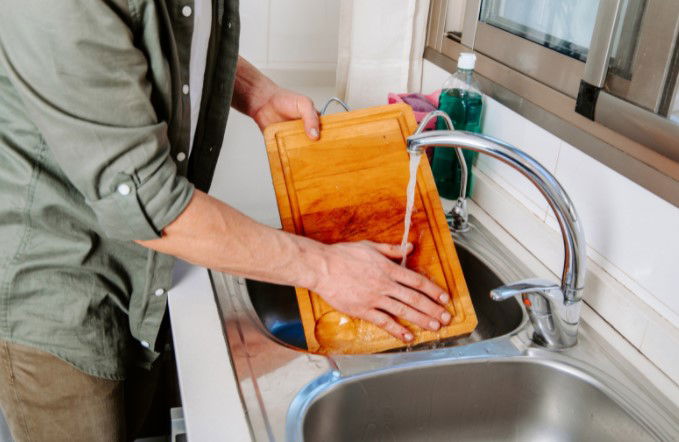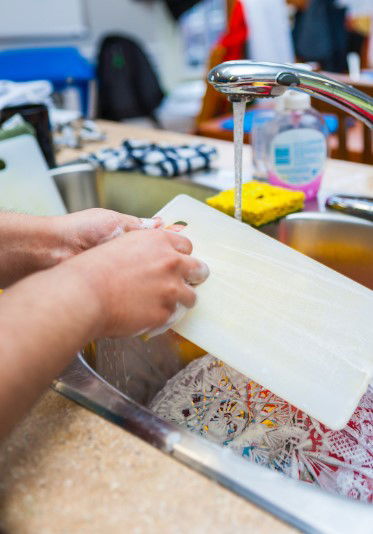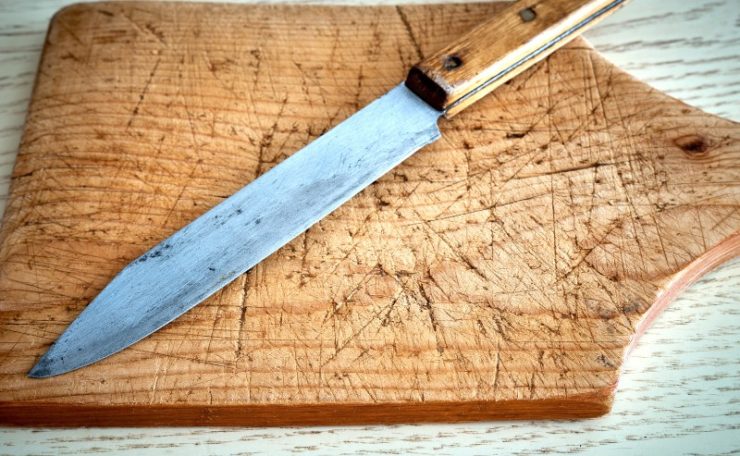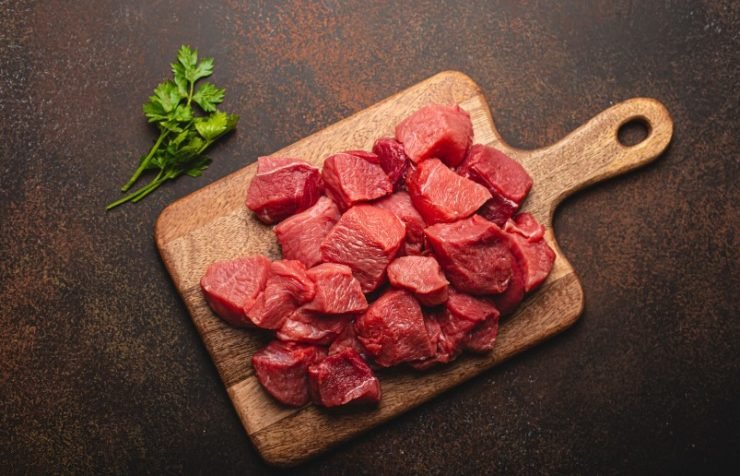Cross-contamination and bacteria like salmonella are valid concerns when you cut raw meat. But cutting raw meat on wooden and plastic cutting boards is safe as long as you follow proper cleaning and sanitizing techniques.
In this article, I’ll share easy ways to reduce the chances of cross-contamination and bacterial growth when you cut raw meat on your cutting board of choice.
After 15 years of cooking in restaurants, food safety was prioritized and practiced at every step. These practices are just as important at home, and you can use common household items to keep your cutting board safe and germ free.
In This Article
How To Clean A Cutting Board After Raw Meat
Wipe And Rinse Your Cutting Board

First, wipe your cutting board with a paper towel to remove any leftover bits of meat.
Then, dispose of the paper towel. While you can use a cloth dish towel for this, I prefer to use something disposable so I don’t risk accidentally spreading bacteria to other parts of my home.
Next, rinse your cutting board with hot water to further remove any small pieces of meat and juices.
Wash Your Cutting Board With Soap And Hot Water
In a sink under hot water, lather up a sponge and vigorously rub all sides and surfaces of the cutting board.
Rinse, and repeat. I don’t like to skimp on this step, and it’s better to be safe than sorry. It was drilled into my head in restaurants to ensure that cutting surfaces were thoroughly cleaned.
If you have a plastic cutting board, you can run it in the dishwasher when you don’t have much time. But, I would encourage you to hand wash both plastic and wooden cutting boards.
Dishwashers can be quite aggressive to a cutting board, which may lead to warping or cracking over time.

Sanitize Your Cutting Board
Soap and hot water do a lot to remove bacteria leftover from meat. But some bacteria can survive a beating, and that’s where sanitizing comes in.
After thoroughly washing your cutting board, pat it dry with a paper towel or kitchen towel. You’ll want the cutting board to be dry before applying any sanitizing solutions for the best results.
Household chlorine bleach is the most common and easy-to-find sanitizer around. Not to mention, it’s very inexpensive.
Now, this stuff is potent and potentially dangerous if not properly diluted. Bleach can be harmful to breathe, can cause chemical burns on the skin, and stain surfaces.
To make a food-safe bleach solution, mix 2 teaspoons of bleach per gallon of cool water. It may not sound like much, but it goes to show just how powerful the stuff is.
A spray bottle is ideal for applying the diluted bleach solution, but you can also wet a paper towel or clean kitchen towel and then wipe down your board.
Be sure to cover every inch of the surface. Bacteria can grow anywhere, especially if you have cuts or cracks in your cutting board.
If you go the spray bottle route, be sure you clearly label what’s in the container and keep it out of reach of children.
After applying your bleach solution, allow the cutting board to air dry. This is an important step that allows the disinfecting power of bleach to do its job. Once completely dry, your board is ready for the next cutting task.
How To Remove Cutting Board Stains
Sometimes, stubborn stains are still on the surface even after you rinse, clean, and sanitize a wooden cutting board.
To easily get rid of them, sprinkle baking soda on a dry cutting board, and scrub any stains with a wet sponge. This will create a mild abrasive paste that can lift most stains. Rinse and completely dry after you’ve gotten the stain out.
Or, try this natural method that relies on lemon juice and salt to completely refresh your wooden board and leave a delightful scent.
When To Get A New Cutting Board?

If your cutting board has severe warping and deep gashes, it’s time to cut your losses and get a new board.
Cracks and gashes are likely to harbor bacteria that’s difficult or impossible to properly clean and sanitize. And warped boards are a pain to use and can be unsafe to cut on.
When it comes time to buy a replacement, whether you go wood or plastic is up to you, but choose something thick and heavy. This will keep your board from moving around while you cut and will be less likely to warp and become unusable.
Your primary cutting board should also be fairly large. An easy rule of thumb is to choose a board that is wider than your longest kitchen knife. This will give you ample room for prep and ultimately be safer to use.
For a great plastic option I like this 1-inch thick professional board. It’s a little expensive upfront, but it won’t warp and you can even resurface it for years of use.
Frequently Asked Questions
How do you remove meat stains from a cutting board?
To remove meat stains from a cutting board, sprinkle a dry cutting board with baking soda and scrub it with a wet sponge or brush. Add lemon juice or diluted bleach for really stubborn stains.
Can raw meat go on a wood cutting board?
Wood cutting boards are fine for raw meat. The key is to properly rinse, wash, and sanitize any cutting surface after use.
How do you remove salmonella from a cutting board?
Rinse and wash your cutting board with soap, and then sanitize with a bleach solution made from 2 teaspoons of bleach to 1 gallon of cool water. A spray bottle is the best way to apply the solution.







